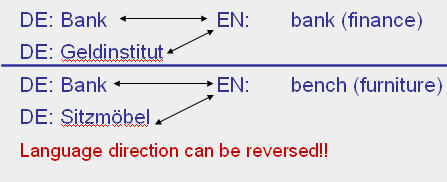
Concept-oriented
Two concept-oriented entries
The other way round, if we prepare the same terminology database but from a concept-oriented approach, where the concept is the starting point, we will have two entries in German: one for "Bank" as finance institution and another one for "Bank" as seating device.
In this case, the language direction of our database will indeed be reversible, because the English "bank" referring only to "finance institution" will be equivalent to the German "Bank" referring only to "finance institution". In the same way, the English "bench" referring to "seating device" will be equivalent to the German "Bank" also referring to "seating device".

Concept-oriented Approach for Translation
Why is a concept-oriented (onomasiological) terminology approach more adequate for translators?
Basically because they work with more than one language and:
- only concept-oriented entries can be mono-, bi- or multilingual
- multilingual terminology is only possible with concept-orientation
- generally the language direction is reversible; i.e. a concept-oriented entry can be accessed from all languages, which is not possible in a strictly term-oriented approach
When working with terminology from a concept-oriented approach:
- Collected terms are organized according to concepts
- Each concept builds an entry, which contains all the terms that represent that concept
- These terms can exist within one language (synonyms) or in different languages (equivalents in other languages)
- When a term corresponds to several concepts (homonyms), several entries must be created

